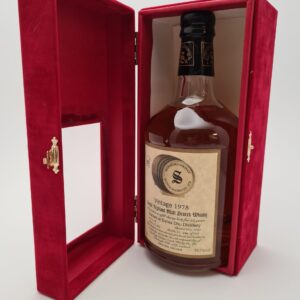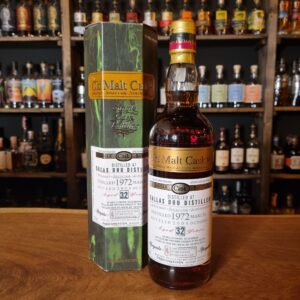Showing all 2 resultsSorted by popularity
Introduction to Dallas Dhu
A destillery frozen in time
Dallas Dhu is a historic Scottish whisky distillery located near Forres in Speyside, one of Scotland’s most celebrated whisky-producing regions. Unlike most Speyside distilleries, Dallas Dhu stands as a perfectly preserved time capsule of traditional Scotch whisky production, having ceased operations in 1983 but maintained as a museum and monument to Scotland’s whisky heritage.
Now managed by Historic Environment Scotland, this silent distillery offers visitors a rare glimpse into traditional whisky-making methods of the early 20th century, with much of its original equipment still intact.
Why we have a soft spot for Dallas Dhu
At Vault of Spirits, we appreciate distilleries that tell a story, and few tell it as completely as Dallas Dhu. What makes this distillery special is how it stands as a perfectly preserved example of whisky production techniques from a bygone era.
While no longer producing whisky, the few remaining bottles from Dallas Dhu represent liquid history – offering whisky enthusiasts the opportunity to taste a spirit that can never be replicated, from a distillery that will never produce again.
The History Behind Dallas Dhu
Origins and development
Dallas Dhu was established in 1898 by entrepreneur Alexander Edward during the whisky boom of the late 19th century. Originally named “Dallasmore,” the distillery was built to satisfy the growing demand for malt whisky needed for blending.
Shortly after completion, the distillery was sold to Glasgow blenders Wright & Greig Ltd, who renamed it Dallas Dhu and used its production primarily for their popular “Roderick Dhu” blend. The distillery changed hands several times throughout its operational history, eventually becoming part of Distillers Company Limited (DCL).
Following the whisky industry downturn in the early 1980s, Dallas Dhu fell silent in 1983, becoming one of the many casualties of the period known as “The Whisky Loch,” when production significantly exceeded demand.
The legacy lives on
Rather than being dismantled like many closed distilleries, Dallas Dhu was preserved as a historic monument. In 1986, it opened to the public as a museum, offering visitors an authentic journey through traditional Scotch whisky production methods.
Today, the distillery stands as a testament to Scotland’s whisky heritage, with its equipment and buildings preserved almost exactly as they were on its final day of production.
The Craft and Production
From raw materials to finished product
During its operational years, Dallas Dhu followed traditional Speyside production methods. The distillery used locally grown barley, which was malted on-site in their own malting floors – a practice that had largely disappeared from most distilleries by the time of its closure.
The whisky was distilled in a single wash still and a single spirit still, both of which are still on display. The relatively small production capacity (around 50,000 gallons per year) allowed for careful attention to every batch.
Maturation and aging
Dallas Dhu whisky was typically matured in traditional oak casks, primarily ex-bourbon and sherry casks, within the cool, damp warehouses on site. This environment, typical of Speyside, contributed to the gentle maturation that characterized the house style.
The few remaining bottles from Dallas Dhu’s production era represent increasingly rare examples of 1970s and early 1980s Speyside whisky making, with each passing year making them more valuable to collectors and enthusiasts alike.
Selected Products from Dallas Dhu
Dallas Dhu 1979 – A window to the past
Bottlings from the late 1970s showcase the distillery in its final productive years. These expressions typically offer the classic Speyside character with notes of orchard fruits, honey, and gentle oak spice. The mouthfeel is often silky with a medium body and pleasant maltiness throughout.
Historic bottlings – For the connoisseur
Independent bottlers occasionally release rare Dallas Dhu expressions, often from single casks that have been maturing for decades. These bottles frequently display remarkable complexity with rich fruity notes, toffee, subtle vanilla, and delicate floral undertones – a testimony to the quality of spirit produced at this lost distillery.
Visit the Distillery
Tours and experiences
Dallas Dhu offers visitors a self-guided audio tour that takes you through each stage of the whisky-making process as it would have occurred during the distillery’s operational days. The tour includes access to all production areas, from the malting floors to the still house and bonded warehouses.
While no active production or tastings take place, the visitor experience provides an educational journey through whisky history that few other locations can match.
Frequently Asked Questions
What is Dallas Dhu?
Dallas Dhu is a historic Speyside whisky distillery that operated from 1898 to 1983. Now preserved as a museum, it offers visitors a unique opportunity to explore traditional Scotch whisky production methods in their original setting. While no longer producing whisky, bottles from its operational period are highly sought after by collectors and enthusiasts.
Where is Dallas Dhu located?
The distillery is located approximately one mile south of Forres in Moray, Scotland. Situated in the Speyside whisky region, its location provided access to the excellent water sources and barley fields that made this area famous for whisky production.
What characterizes Dallas Dhu whisky?
Dallas Dhu whisky is known for its classic Speyside character – typically displaying fruity notes, malty sweetness, and gentle spice. As a “lost distillery,” each bottle represents a unique piece of whisky history that cannot be replicated, with older expressions showing remarkable depth and complexity developed through decades of maturation.
Where can I buy whisky from Dallas Dhu?
As a closed distillery, Dallas Dhu whiskies are increasingly rare. At Vault of Spirits, we occasionally source authentic bottles from this historic distillery. These limited offerings represent a diminishing supply of a whisky that can never be produced again, making them particularly special additions to any collection.

